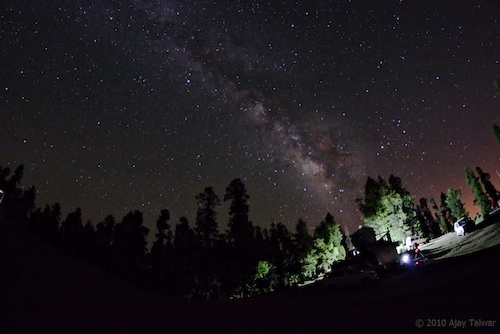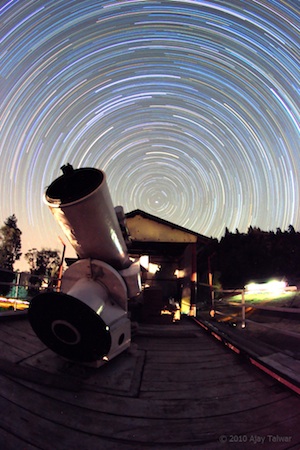GAM 2012 Blog
|
April 19 By Ajay Talwar |
Back to the GAM Blog |  |
| No internet mapping sites makes or measures the route for you. The pine filled road is not even visible in Google Earth. |
||
On the way to DOT (Devsthal Optical Telescope) I passed Kathgodam, Bhimtal, Padampuri, Dhanachuli Bend, Devsthal. The route to Devsthal is approximately 40 kms from Kathgodam - the gateway to the hills. On the road I saw very few vehicles and not many tourists. In about one hour from Kathgodam, which is at a height of less than 500 metres, I had climbed to a height of 2424 metres. Dhanachuli bend is the last four road crossing you encounter on the route upwards where you have a few shops, tea stalls and restaurants. The last village that you encounter, Jhirapani, seems like an abandoned one. The road to the observatory campus leads from in-between two houses; you would certainly miss the turn unless youíve been told. I just wonder when the transport carrying parts of the biggest telescope arrives here, how it will turn towards the last road. A sky blue coloured board proclaims the site to belong to A.R.I.E.S. and that entry is restricted.

The road leading inside the campus has been metalled recently and the 3 km drive inside is smooth. The campus is full of Pine, Oak, Cedar and other exotic trees, all tall, old and majestic, rising till great heights on the hilly slopes. The campus is 3 kms long but has very little flat or clear area. The observatory would have to be built only in places where nature allows. Continuing on the observatory campus road, you see that some essential buildings like the store room, power distribution room, have already been completed and a guest house is under construction.
 Halfway on the road, there exists a beautiful meadow. A vacant grassy plot surrounded on three sides by the natural sky scrapers - trees. I settled my 8î telescope at this beautiful spot for the Venus Occultation the next day, right beside the ancient 22î telescope shed. A little distance away is a prefabricated two room guest house, complete with all facilities including an internet & UPS enabled windows desktop, wow, all within 50m of my observing site. Ideal is the correct word, and all thanks to the hospitality provided by ARIES. Thanks Prof. Ram Sagar and Dr. Wahab Uddin.
Halfway on the road, there exists a beautiful meadow. A vacant grassy plot surrounded on three sides by the natural sky scrapers - trees. I settled my 8î telescope at this beautiful spot for the Venus Occultation the next day, right beside the ancient 22î telescope shed. A little distance away is a prefabricated two room guest house, complete with all facilities including an internet & UPS enabled windows desktop, wow, all within 50m of my observing site. Ideal is the correct word, and all thanks to the hospitality provided by ARIES. Thanks Prof. Ram Sagar and Dr. Wahab Uddin.
Itís almost a secret new site. Itís almost like no one knows about it. I am sure that is about to change in a few months from now, but for now the meadow was beautifully welcoming for the three nights I spent at Devsthal. Soon enough the meadow will be the busy place to store the arrival of all the parts of the 3.6 metre telescope, the largest in Asia. The large, thin mirror telescope will be setup at the end of the 3 km road on the peak. The telescope will be on a modern Alt-Azimuth mounting and a new style dome, as opposed to a classical dome with a vertical window. The natural prevailing winds from the north west would be effectively used to cool down the telescope temperatures before it is time to open the observatory in the evenings. The actual telescope would also be at a good height from the ground level, on the peak. One, because the trees would not have to felled and second, the height of telescope would eliminate the local thermal effects of the grounds surrounding the observatory, both of the reasons more important than the other! The telescope is scheduled for installation completion at the end of year 2012.
Closer in time though, is another telescope, a 1.3 metre telescope, which should be ready by the beginning of the next year. I went and saw the enclosure, unconventional for such a large telescope, is a roll off roof, completely baring the telescope to the weather outside, which would make it perform better. The 1.3 metre telescope would be installed on an equatorial fork mount. At the time I was at Devsthal, the news was received that the telescope had arrived at Delhi and customs inspection was being carried out.

A little in the future, as Prof. Ram Sagar told me, Devsthal will have a 4 metre Liquid Mirror Telescope installed. As the telescope will be fixed, it will only be able to ëLook Upí, at a narrow band of the sky, and will not be able to track any sky objects. The only small amount of tracking that would be possible, when the object would fall within the field of view of the large CCD installed at its focus, as the object would traverse the CCD pixels, software would negate the moment.
As you can imagine I was excited being at such a beautiful astronomical spot with clear blue skies, and equally excited at the prospects of this site, DOT, to becoming a great centre of optical astronomy in India. A future that I can almost imagine effortlessly. Here is one photo that I shot here during my 3 night stay at the DOT, which almost describes the meadow where I was.
Will the meadow stay though?
_____
This blog was written after a visit to DOT in May 2010.
|
|
Ajay Talwar took up astrophotography in 1987 during a night when the Moon was occulting the Pleiades. Since then he has continued photographing the skies passionately. He is the most prolific transient sky events photographer in India. One of his early accomplishments was to produce an exhibition of all Messier objects along with three other Indian astrophotographers. Ajay travels with all his astrophotography gear to all across India, especially the Himalayas, places like high altitude Indian Astronomical Observatory at Hanle, Ladakh, high peaks in Himachal Pradesh. His interest to dark skies also take him to the white desert in the northwestern India. Ajay Talwar regularly holds astrophotography workshops, including practical programs in the Himalayas where participants are provided necessary equipment to photograph the sky. India is an enormous country of natural and cultural diversity. Through his TWAN contribution Ajay hopes to photograph many of India's heritage under the starry sky. Ajay is blurring the sharp divide between scientific astrophotography and artistic photo-journalism. In 2011 he was invited to attend a month long residency by the Khoj International Artist’s Association. At the end of ‘Shifting Focus’ his work was exhibited at the Khoj Studios, New Delhi. |








